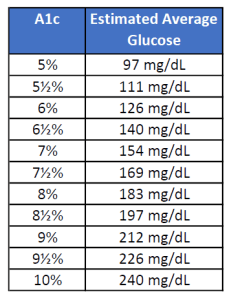- Try to avoid eating a lot of sugar, or other carbohydrates, at one meal. An ounce is 28.35 grams. My suggestion would be to have no more than 25-30 grams (1 oz) of carbs at any given meal.
- For the most part, avoid cereal at breakfast as it is usually high in carbs. There are exceptions, of course, such as oatmeal. Try something high in protein instead, such as eggs. Have a look at the Eat This, Not That website to get some great ideas for high protein breakfasts.
- Check your blood sugar level 2 hours or so after meals. That way, you get to learn what foods work for you and you can plan menus accordingly.
- Avoid white foods. This is definitely something you will want to experiment with. White food generally refers to foods that are white in color and that have been processed and refined, like rice, pasta, bread, cereal, spaghetti, and sugars. I usually substitute brown bread, brown rice, and brown noodles. I also find that I need smaller portions because they make me feel full for a longer period of time. On the other hand, I find that my body can handle potatoes quite well so this is not an exhaustive list by any means. Try and find out exactly what you can eat without spiking your blood sugar.
- Fill half of your plate with vegetables – and eat them!
Please note that the content presented here is for your information only. It is not a substitute for professional medical advice, and it should not be used to diagnose or treat a health problem or disease.






 Think of yourself as a person with diabetes, not as a diabetic. View having diabetes the same way that you would view a sight defect. By and large, your eyesight can be corrected. Of course, you my have to wear glasses or contact lenses, but it is not going to define your life regardless of the fact that it is part of it. Think of diabetes in the same way. Taking your blood sugar level on a regular basis should be no more inconvenient than keeping your glasses clean. High A1c level? Work out a plan to get it lower again. After all, eating healthy should be the aim of everybody.
Think of yourself as a person with diabetes, not as a diabetic. View having diabetes the same way that you would view a sight defect. By and large, your eyesight can be corrected. Of course, you my have to wear glasses or contact lenses, but it is not going to define your life regardless of the fact that it is part of it. Think of diabetes in the same way. Taking your blood sugar level on a regular basis should be no more inconvenient than keeping your glasses clean. High A1c level? Work out a plan to get it lower again. After all, eating healthy should be the aim of everybody. short-term. For example, if you have only recently been diagnosed, taking your meds on time, and checking your blood sugar when you should, may be sufficient. If you know you need to lose weight, make a realistic goal of losing 5 pounds every month rather than a much more daunting like losing 60 pounds over the year. This cartoon from
short-term. For example, if you have only recently been diagnosed, taking your meds on time, and checking your blood sugar when you should, may be sufficient. If you know you need to lose weight, make a realistic goal of losing 5 pounds every month rather than a much more daunting like losing 60 pounds over the year. This cartoon from 
 mushrooms are one of my favorite veggies may mean my opinion is not entirely unbiased. This recipe is for one person, so double the quantities for two. I prefer to get the egg mixture ready before I start so that I can add it to the pan as soon as I remove the veggies, mainly because I do like my omelets to be hot rather than lukewarm, and definitely not rubbery.
mushrooms are one of my favorite veggies may mean my opinion is not entirely unbiased. This recipe is for one person, so double the quantities for two. I prefer to get the egg mixture ready before I start so that I can add it to the pan as soon as I remove the veggies, mainly because I do like my omelets to be hot rather than lukewarm, and definitely not rubbery.
 you when going through airport security. make sure the letter states your need to carry insulin, syringes, test strips, and any other supplies you may need. Along the same lines, make sure that you carry pill bottles and insulin vials which include pharmacy labels. This is not essential, but can avoid a lot of questions. Not that you would have anything to hide, but air travel is stressful enough as it is, so any way of reducing the stress should be looked for.
you when going through airport security. make sure the letter states your need to carry insulin, syringes, test strips, and any other supplies you may need. Along the same lines, make sure that you carry pill bottles and insulin vials which include pharmacy labels. This is not essential, but can avoid a lot of questions. Not that you would have anything to hide, but air travel is stressful enough as it is, so any way of reducing the stress should be looked for. than your eyes? Well, maybe a few things, like your heart and lungs, but can you imagine what your life would be like without your sight? Of all the various side-effects of diabetes, nerve pain (or diabetic neuropathy) is one of the more well-known, but did you know that it can also affect your eyes? This, of course, raises the subject of how often you should visit the eye doctor, and what questions you need to ask when you do go. There is every reason to go to the eye doctor if you are diabetic, regardless of whether or not you currently have perfect vision. In order to help protect your sight, learn the dangers and how to address them. Possible vision problems include
than your eyes? Well, maybe a few things, like your heart and lungs, but can you imagine what your life would be like without your sight? Of all the various side-effects of diabetes, nerve pain (or diabetic neuropathy) is one of the more well-known, but did you know that it can also affect your eyes? This, of course, raises the subject of how often you should visit the eye doctor, and what questions you need to ask when you do go. There is every reason to go to the eye doctor if you are diabetic, regardless of whether or not you currently have perfect vision. In order to help protect your sight, learn the dangers and how to address them. Possible vision problems include 

 example, you are less likely to allow yourself to slide on the little things because you know that others will be watching. Nowhere is this more true than in the family, and you will want your spouse and children to be able to look up to you and rely on you to do what you say you will do. Especially, do not try to hide your diabetes. The fact is, managing your diabetes affects so many aspects of your life that you cannot go it alone. For example, you need to eat healthy foods, but you are not going to be able to do that without the cooperation of everybody who lives under your roof. And besides, the healthy lifestyle changes you need to make will benefit all of you. Try these tips:
example, you are less likely to allow yourself to slide on the little things because you know that others will be watching. Nowhere is this more true than in the family, and you will want your spouse and children to be able to look up to you and rely on you to do what you say you will do. Especially, do not try to hide your diabetes. The fact is, managing your diabetes affects so many aspects of your life that you cannot go it alone. For example, you need to eat healthy foods, but you are not going to be able to do that without the cooperation of everybody who lives under your roof. And besides, the healthy lifestyle changes you need to make will benefit all of you. Try these tips: